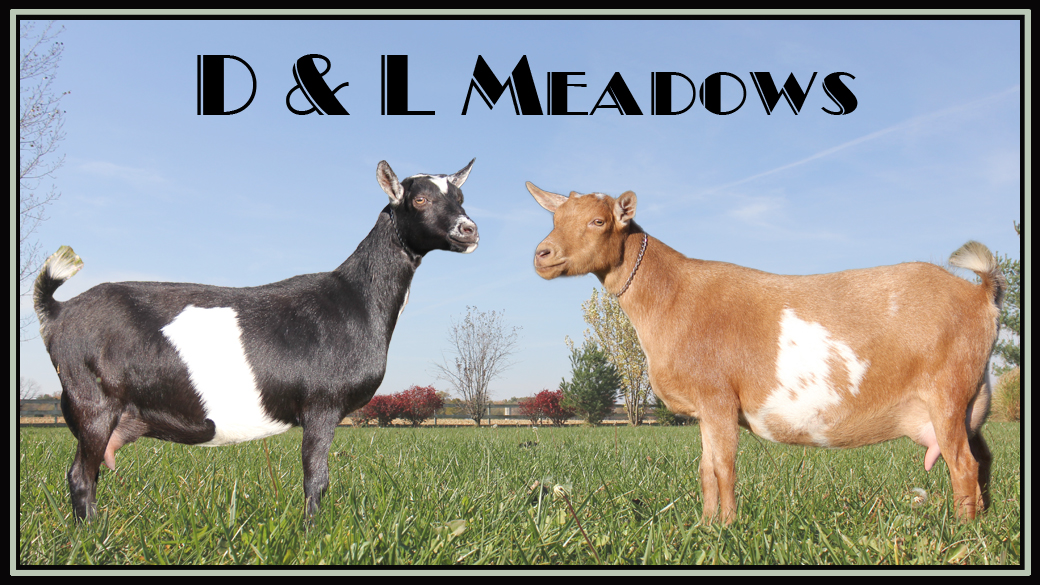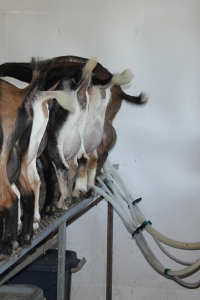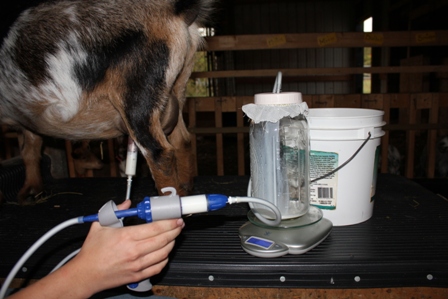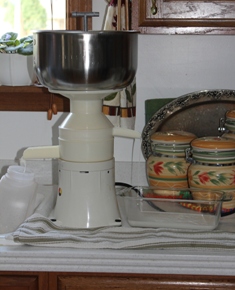
Grade A Dairy

We obtained in January 2017, our grade A dairy farm license. The cheese maker also makes yogurt for which he needs Grade A milk. We had to build a grade A milk house and change our milking parlor. We bought a Grade A milk stand from a former goat farmer that went out of business. It holds 12 goats. What Grade A milk stand means is that it is made of steel instead of wood. We can milk two goats at the same time with one milk bucket. It took some time for our does to get used to the milk stand.
Hand Milker

Maggidan milker in operation
In the past, we used the Maggidan hand milking machine for several years. We love it and it works great.
It is a good idea to buy extra of them, since they occasionally get mechanical problems. A back up unit is always handy and they are not expensive. We do use a glass jar instead of the
plastic container.
Since we consume the milk raw, it is necessary to have the milk
extremely clean. Hand milking causes a lot of hairs and dirt to fall
into the milk. To filter the dirt and hairs out for 100% is nearly
impossible. The hand milking machine comes in handy since no dirt
can fall into the milk bucket. We do have a cheese cloth on top of
the jar and between the lid. The milk passes through this filter for
just in case a speck of dirt gets in. We rarely find anything on the cheese cloth.
However, now that we have obtained our farm license for Grade B Milk
(obtained in 2015) we no longer use the Maggidan hand milker. The Maggidan hand milking machine does not pass inspection due to the
plastic parts involved.
Yes, we do use raw milk and we are aware of the potential problem that
consuming raw milk has. But, regarding food poisoning, what is more dangerous, eating a salad at a restaurant, or
drinking your own goats milk?
There are several precautions that should be taken. Shave the goats
udder so that it can be cleaned easily. Use a milking machine and
do not milk by hand. Before engaging the milker, strip out a few squirts of milk, and then start milking. Afterwards, strip the
udder empty but don't use that milk for consumption.
After milking, we put the milk in the freezer for 45 minute to cool the milk down fast.
Milking records
We are now in a Dairy Herd Improvement (DHI) program.
What this means is that every month a milk tester comes to our mini farm and weighs the milk and sends samples to the
laboratory. We uses DHI Cooperative from Columbus,
Ohio.
The pros of milk test is that we have official milking records and
many of our does have become star with the one day milk test or with
the Advance Registry. The cons of milk test is that it is not cheap
and a lot of time and effort.
Check out our Star Calculations page to see if your goat qualifies for a star. A handy tool before you actually enroll in the DHI program to see if your goats has a chance of obtaining a star with AGS or ADGA.
The way that the total milk production is calculated from the milk test and is not straight forward. If one takes the number of days and multiply the number of pounds of milk and add these all up for the different milking test days, there will be a different total number than what the DHI paper work tells. There is a correction factor that is used to calculate the total pounds of milk. That correction factor depends on the number in days in milk. For the very first test, this factor is between 0.8 and 0.9 depending on the age of the doe and the number of days in milk. For instance, Tehillah gave 2.7 lbs of milk on day 25 in milk. The correction factor is 0.82. The total milk is 25x2.8x0.82 = 55 lbs of milk. Smarty in 2013, was first tested on day 118 in milk. The correction factor used is 1.02. To add to the confusion, the factor for the butter fat and the factor of the protein calculations are each different. The DHI Cooperative send the information of the milk test to the Dairy Records Management Systems and they have the table for this factor. After the second milk test, there are no correction factor. Most of the time, there is no correction factor with the second milk test day. The total volume of the milk is calculated from the current milk test and the previous milk test using both numbers weighted equally according to the number of days in between the test. For example, a doe gives 2.0 lb and has a total volume of milk of 500 lbs. The next test day, lets assume 30 days later, she gives 1.8 lbs of milk, then the new total volume of milk is 500 +2.0x15+1.8x15 = 557lbs of milk.
How easy is it to get started? The first step is to visit the AGS and ADGA website to get the correct paper work going. Next, if you live a far distance from the DHI cooperative, you need to find a person in your neighborhood who is willing to do the milk test for you. That person needs to get trained with the DHI supervisor. If you live in Ohio, call Dale Higgins to set up an appointment for him to come. Arrange that your future milk tester is there as well on that day. We have also a second person as back up. Make sure you have a scale which needs to be certified by the DHI supervisor. The DHI supervisor will train the milk tester regarding putting milk in the test tubes, showing how the paper work is filled out, etc. The supervisor can give you a cooler box for the future samples to be mailed in. The first test is expensive for you have to pay for the traveling expenses as well. Count on $150 to $200. The next time, it is just your milk tester and he/she sends the samples to DHI center. You get invoiced by DHI for the lab test which is between $30 and $40 depending on how many goats you have. Also you might have to pay your local milk tester as well. Shipping cost are around $10.- Every month, the DHI send you the cooler box with the tubes back to you. On average, it cost us $80.- per month for the DHI program.
Cream Separator

Goats milk is naturally homogenized. A cream separator is needed to separate the cream from the milk. Nigerian dwarf goats are known for their high butterfat. Our goats butter fat varies from 5 to 9.9%. We are using the Mini Cream Electrical Separator sold by Coburn. Although it works good, there are some issues of the glue not sealing the floater very well. We now repair our own floater with FDA approved epoxies. We had once problems with the rubber ring at the bottom of the tank and ended up buying a new tank. Although expensive, a cream separator is very rewarding for without it, no cream can easily be obtained.
Besides many difference between cows and goats milk, there is one fact that is very important for separating cream. The body temperature of a cow is 100F while of a goat is 101.5 to 104F. We found that heating the milk up to 103 F works the best.
We had our share of troubles with the Coburn milk separator. Here some advise in case you have one.
If the cream is very watery in the beginning of the process, check the floater. Most likely there is water
and milk inside the floater. You can either buy a new one, or repair it.
If the milk is pouring out of the hole of the Float Chamber, then either the floater has water/milk inside, or the red
rubber ring is not sealing well. Both problems can be fixed by using FDA approved epoxies. Those glues are used to
glue equipment that process food and are safe to use.
With 5 quarts of our Nigerian dwarf goats milk we get about two cups of cream.